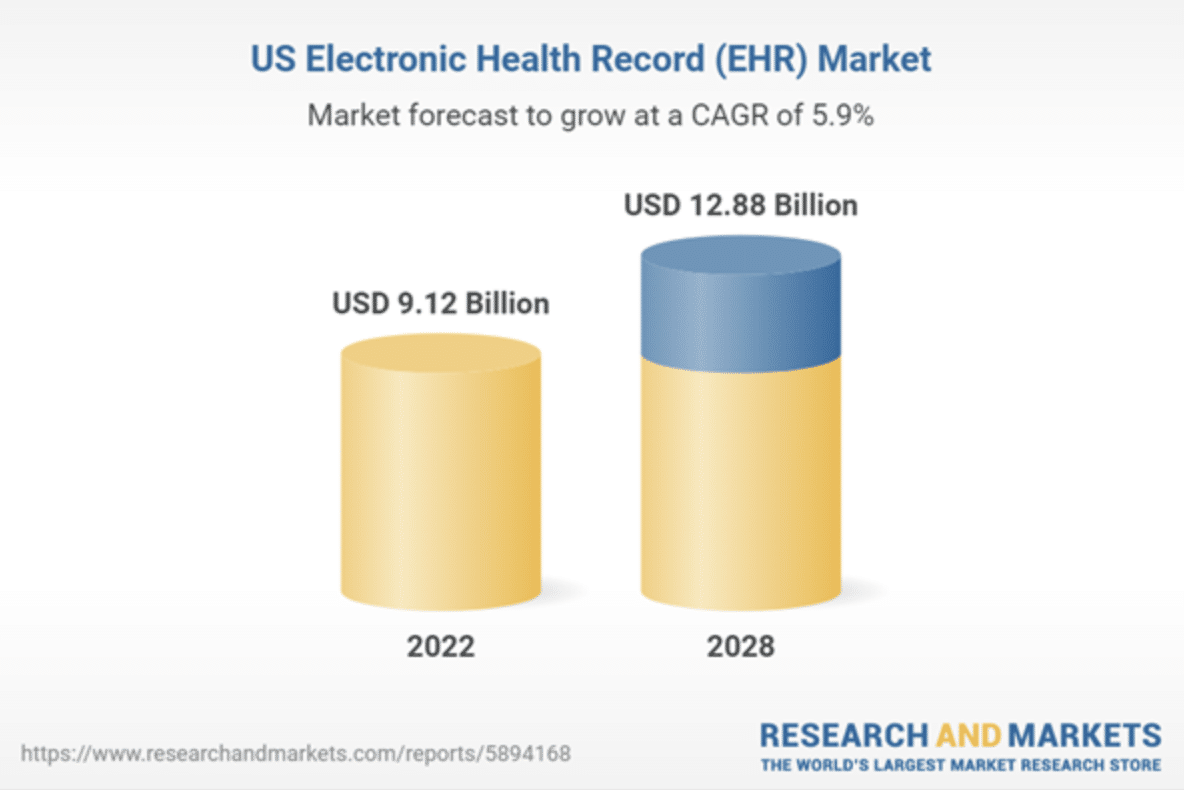Breaking Down Silos: Best Practices for Integrating Medical Device Data into EHR/EMR Systems
All major societal sectors are undergoing a data revolution, and healthcare is one of the hot spots. In recent years, advanced medical devices and other healthcare IoT devices have emerged as huge data sources. These innovations generate valuable patient healthcare data, offering unprecedented insights into health and well-being.
The challenge today is that this data often resides in isolated systems, creating silos that hinder effective patient care. Silos form when medical devices don’t contribute efficiently transfer data to Electronic Health Records (EHR) or Electronic Medical Records (EMR) systems.
In a high-functioning system, EMR and EHR integration seamlessly connects patient healthcare data from various sources, including medical devices, into a centralized resource for patient records.
Big Data, Big Business
Electronic Medical Records integration is a big business slated to grow even larger.
According to Markets and Research, “Electronic Health Records (EHR) in the United States has seen remarkable growth, with adoption rates soaring post-COVID-19. As of 2021, an impressive four out of five physicians, and over 90% of non-federal acute care facilities, have embraced EHR systems. This trend continues to escalate, driven by ongoing healthcare reforms.”

The United States EHR market is expected to reach almost $13 B by 2028. Device companies prioritizing EHR data integration will likely have a competitive edge in benefiting from this growth.
This post examines the challenges and best practices for integrating medical device data into EHR/EMR Systems.
The Problem with Data Silos
A disconnect between medical devices and EHR/EMR systems creates several challenges:
Incomplete Patient Picture: Clinicians lack a comprehensive view of a patient’s condition. Access to real-time device data in health records is necessary to understand crucial details about a patient’s health level, making it difficult to make informed decisions.
Inefficient Workflows: Data entry from devices into electronic medical record systems is often manual and time-consuming, leading to workflow bottlenecks and potential errors.
Hindered Innovation: Device data holds immense potential for data-driven decision-making and improving medical devices. However, fragmented data in medical records makes it difficult for medical device companies to analyze trends, identify areas for improvement, and develop next-generation solutions.
The Power of Seamless EHR/ EMR Integration
Medical devices can unlock their potential by integrating medical device data with EHR/EMR systems. Here’s how seamless medical device integration empowers both patients and providers:
Improved Patient Care
Through access to real-time patient data from devices, clinicians gain a real-time, holistic view of a patient’s condition. This allows for more personalized treatment plans, improved patient outcomes, and better patient care.
Enhanced Workflow
Seamless data integration eliminates the need for manual data entry, streamlining workflows for increased efficiency in hospitals and clinics. This frees up valuable time for healthcare providers to focus on what matters most – their patients.
Data-Driven Innovation
Device companies can leverage device data to gain valuable insights. By analyzing large datasets, they can identify areas for improvement in existing devices, accelerate the development of next-generation solutions, and ultimately contribute to advancements in healthcare technology.
Improved Population Health Management
Seamless device integration can contribute to advancements in population management. By providing real-time insights into patient health trends, health systems can develop more targeted preventative care strategies and resource allocation plans, ultimately improving health outcomes.
Bridging the Gap with Device Integration Software
Device integration software offers powerful tools to revolutionize how healthcare professionals deliver care. These solutions go beyond simple data transfer, transforming workflows, and empowering a more patient-centric approach.
Streamlined Workflows: Software automates data transfer from devices into EMR systems, eliminating the need for manual data entry. This frees up valuable clinician time for what matters most – focusing on patient care and improving clinical workflow efficiency. Additionally, the software can automate tasks like appointment reminders and medication management, further streamlining practice management for healthcare providers.
Enhanced Patient Engagement: Software can facilitate the development of secure mobile apps for patients. These apps give patients real-time access to their health data, medication schedules, and educational resources. This fosters patient collaboration in their care journey, ultimately leading to a more positive patient experience.
Data-Driven Decisions: Seamless access to real-time and historical device data is a game-changer for clinical decision support. Clinicians can leverage this data to make informed decisions at the point of care. Data analysis tools within the software can identify trends and patterns, enabling healthcare providers to develop personalized treatment plans and optimize care delivery.
Improved Cost Savings and Efficiency: The right software can significantly reduce administrative burdens and automate workflows, resulting in significant savings for healthcare organizations.
Best Practices for Seamless Integration
Achieving seamless EMR/EHR integration requires careful planning and execution. Here are some essential best practices to consider:
Standardization is Key: Healthcare has established interoperability standards like HL7 FHIR to ensure smooth data exchange between devices and EHR/EMR systems. Utilizing these standards during software development is crucial for seamless EMR/EHR integration.
Security & Compliance: Patient data is highly sensitive, and healthcare providers acutely understand that data security must be a top priority. Integration solutions should incorporate robust data encryption measures to protect patient privacy and comply with regulations like HIPAA.
Partner with a Data Management Expert: Successfully navigating the complexities of medical devices with EHR/EMR integration requires expertise. Choosing a partner with a proven track record in the field and a deep understanding of medical device data is essential.
Focus on Scalability: As your devices gain traction and usage grows, the volume of generated data will increase. Select an integration solution that can scale to accommodate this growth and ensure smooth data access and management.
User-Friendly Interface: Software integration should not create additional burdens for clinicians or device users. A user-friendly interface for both parties is essential for successful adoption and maximizing the benefits of integration.
The Right Partner is Crucial
Choosing the right partner for medical device integration is critical to the success of your project. Look for a partner who offers the following:
Deep Understanding of Medical Devices: They should possess a comprehensive understanding of the industry landscape, the specific needs of your devices, and the regulatory environment.
Proven Medical Device Integration Expertise: Experience in developing and implementing successful device integration solutions is crucial. Look for case studies and a proven track record, especially with cloud connectivity.
Commitment to Security and Compliance: Their software solutions should prioritize robust data security measures and ensure compliance with relevant regulations.
Scalable and Flexible Solutions: They should offer software that can scale with your needs and adapt to future technological advancements.
Focus on User Experience: The partner should prioritize user-friendly interfaces for clinicians and device users to ensure seamless adoption and maximize the benefits of integration.
For example, secure healthcare apps can provide real-time access to health data collected by medical devices, medication reminders, and educational resources tailored to their specific condition.
Future-Proofing for Clinical Trials: Seamless device integration can also benefit medical device companies in future clinical trial management. By capturing and storing real-time device data throughout the trial period, these solutions can streamline data collection and analysis, potentially leading.
By partnering with a company that fulfills these criteria, you can ensure a smooth and successful device integration process, unlocking your devices’ full potential to improve patient care.
Moving Ahead With Best Practices for Integrating Medical Device Data into EHR/EMR System
The potential of medical device and patient data integration to revolutionize healthcare is undeniable. By following the best practices outlined above and partnering with a reliable platform like Galen Data, clients can break down data silos and drive innovation.
For a deep dive into our approach, you can check out our webinar
EHR Integration Through Live Demonstration of Galen’s Cloud Platform.
Galen Data is your trusted partner for device data integration and management. We understand the industry’s unique challenges and are dedicated to providing secure, scalable, and user-friendly solutions. At Galen Data, we know every device is different, and every team has a unique perspective. Contact us today to discuss your specific needs.




